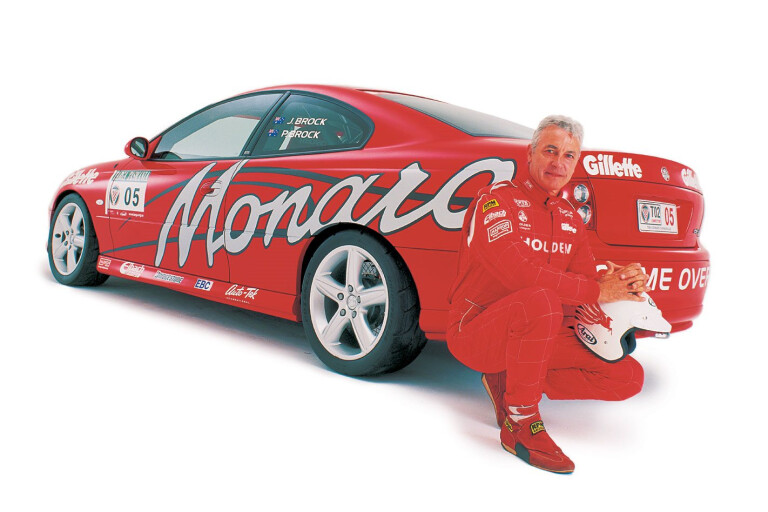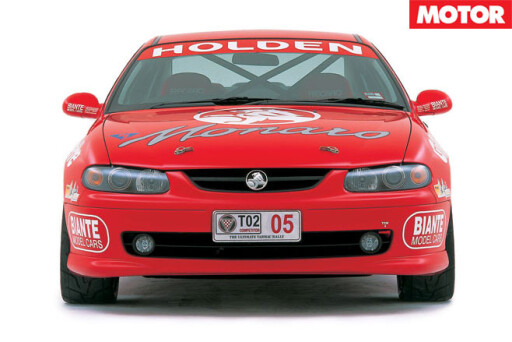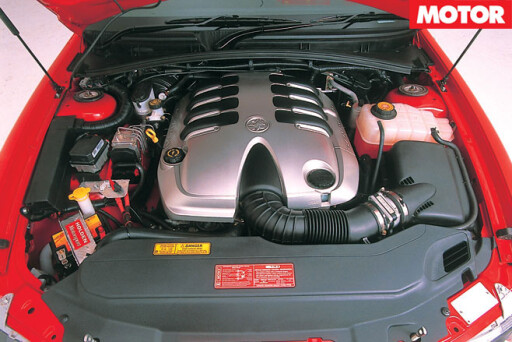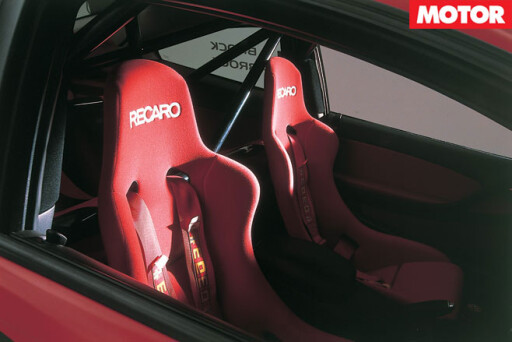
Old race drivers don’t retire; they just do Targa. Last year Brock completed the event in an SS Holden Ute, and got pretty used to being mobbed on the way to and from the car.
This feature first appeared in the April 2002 edition of MOTOR.
But he always made the time for an autograph or a happy snap for the mantle-piece back home, despite the time pressures of an open-road event. It’s debatable what Brock did more of – gear changing or autographing – during the 2001 Targa Tasmania.
Holden, high on the hog with the success of the Gen III VT and VX, took a look at that, factored in the absence of a Tasmanian V8 Supercar round, and saw several hundred thousand good reasons to fling a couple of Monaros Brock’s way. It doesn’t get any better for Holden fans, when Brock will be Holden’s motorsport ambassador to Tasmania, in a Brock-tweaked Monaro.
Brock describes the Monaro as an “outstanding competition vehicle” after copping the race tuning equivalent of a “haircut and shave”. In fact, the ‘haircut and shave’ project began with Brock’s clear directive to sling together a purpose-built tarmac rally screamer with factory integration up to here.
 Brock’s rat pack of Holden-heritage hot-tuners, including engineering guru Ron Harrop, Peter Muir of Bond Roll Bars fame and the chaps at HM Headers, plus Brock’s very good friends at Bridgestone and Mobil, have produced a package in which all the performance bits bolt up to the factory structure, and blur the line in between. In the process, some important bolt-on enduro competition bits for both Commodore and Monaro have been developed.
Brock’s rat pack of Holden-heritage hot-tuners, including engineering guru Ron Harrop, Peter Muir of Bond Roll Bars fame and the chaps at HM Headers, plus Brock’s very good friends at Bridgestone and Mobil, have produced a package in which all the performance bits bolt up to the factory structure, and blur the line in between. In the process, some important bolt-on enduro competition bits for both Commodore and Monaro have been developed.
And there’s one thing that the Monaro beats the upmarket hardware on: it’s got street cred a gogo. Brock’s been driving the car on local roads around his home, and he’s lost count of the 20-somethings who follow, chase, pass (guess he lets them, huh?), stop and get out to give him the thumbs up.
Maybe that’s not quite another victory lap at Mount Panorama, but seeing Brock jumping out of his skin to duke it out with the Eye-ties, the Krauts and the Poms on the best road-course competition on Earth has gotta be the next best thing, right?
 Maybe Brock’s come full circle. The philosophy behind this car isn’t all that different to that which went into PB’s ATCC XU-1 Torana when he made his debut way back in round two at Calder Park in 1972.
Maybe Brock’s come full circle. The philosophy behind this car isn’t all that different to that which went into PB’s ATCC XU-1 Torana when he made his debut way back in round two at Calder Park in 1972.
Thirty years on, V8 Supercars have become a megabuck amalgam of hi-tech and unobtainium, and the young guns are at the top. However, Brock’s still the lay-down misere, winning-est Australian race driver ever, and he’s back to doing motorsport exactly like he did when he kicked off. And, as Maxwell Smart would say, loving it.
Munro-Mumbo
Gen IIIs love a rev, but thanks to Ron Harrop’s engine tweaks and the new HM Headers exhaust bits (Targa rules prohibit actual headers), this one loves it better than most. Brock says the biggest advantage of more revs is not unsettling the car because you have to change up, then back, on your way into a bend. Holding the gear longer, even if there’s a slight horsepower penalty, is preferable.
 An inlet massage by Harrop improved flow, and spark and fuel maps were tweaked to suit PULP fuel. Dyno figures aren’t available, but peak power is at 5800 rpm. It’ll rev to 6500 rpm without drama, according to Brock, but the stock cutout at 5950 rpm has been ditched because “6300 is about where we want to be”.
An inlet massage by Harrop improved flow, and spark and fuel maps were tweaked to suit PULP fuel. Dyno figures aren’t available, but peak power is at 5800 rpm. It’ll rev to 6500 rpm without drama, according to Brock, but the stock cutout at 5950 rpm has been ditched because “6300 is about where we want to be”.
There’s now a single exhaust pipe at the front, and he plans to drop the rear pipes over some of the special stages even though there’s no direct performance benefit. “If I can crank it up sideways in front of the crowd, have a wave with one hand and make a lot of noise in the process,” he says, “I think there will be a certain amount of pleasure in it.”
Inside edge
Peter Brock does Street Machine: There’s a blueprint here for all aftermarket Monaro-modifiers. Stripping out the interior and plastering it with aluminium sheet didn’t fit in with Brock’s factory integration theme. And when they found out it wouldn’t save significant weight (just 2-3 kg), the decision to tweak the interior trim around the Bond roll cage became a no-brainer.
Bond’s been pumping out competition roll cages since the original GTS 350 Monaros in 1969, and he’s less exxy than a lot of the competition, according to Brock. Roman Autotek coughed up the Recaro competition seats, the MOMO ‘Race’ steering wheel, matching shifter and pedal pads, and the six-point MOMO competition harnesses. The floor trim? Lightweight black carpet. Looks factory, but isn’t.
 Cornering the king
Cornering the king
Peter Brock has won more of everything than anyone else in Australian motor racing. It’s that simple. He’s had one podium finish for every two starts over 25 years. His first Australian championship title was in 1968 (hillclimb), and since then he’s backed that with nine victories outright at Bathurst and Sandown, 57 ATCC pole positions, 37 ATCC wins, earning a total of 2657 ATCC points.
If you wanted a cornering lesson, we can’t think of a better teacher. Here it is: “I’ve always arrived into a corner faster than most. Just by a few kays. I turn in hard to wash off the speed – just rip the wheel in – and you need a wide, late entry to do that. Then I let it all settle, and feed the power in for the exit. I’m off the throttle until after the apex.”
Brock says eight-tenths everywhere is the go for an event like Targa, although plenty of blokes will proceed to scare themselves silly for several days. He’s a big fan of driving with “circumspection [because] the consequences are very important” when driving down a mountain at warp speed on a wet road with a 100-metre drop on the outside.
 Harrop's brakes
Harrop's brakes
Brock says the Monaro has more brake capacity than a V8 Supercar. That’s due to the 18-inch wheels (V8 Supercars run 17s) together with new Harrop Engineering discs and calipers. The discs only just fit inside the factory wheels, and comprise an iron rotor with an aluminium hub cast in.
The reason? To cure ‘coning’, which is where the inside and outside faces heat up and expand at different rates because of the different metal masses on each side, turning the disc cross-section into a cone.
That’s bad. Harrop’s setup also shaves 3 kg from each corner. Six-piston calipers are at the front; four at the rear, with EBC pads that have been incorporated into the system by Harrop to leave no redundant unswept area. Clever. Mobil Mountain Magic competition brake fluid runs in its veins. ABS is retained, a task made easier by Harrop’s balancing of the factory hydraulic ratios front and rear.
Chassis tweaks
The chassis was the Great Unknown during the build. Monaros are more rigid (than SS), have different weight distribution and a different polar moment of inertia, which affects how they turn in.
The car sits 25mm lower on all corners, yet offers 25mm additional wheel travel, thanks to Eibach variable rate springs and Bilstein dampers. The car needs compliance to perform over Targa, Brock says, so spring rates are comparatively soft.
 Harrop also sorted a front hub/strut package that simply bolts up, allowing for three degrees of negative camber and seven degrees of castor. The result? Better high-speed stability and less squirming under brakes. It’s another potential bolt-up kit for Monaro and Commodore modifiers.
Harrop also sorted a front hub/strut package that simply bolts up, allowing for three degrees of negative camber and seven degrees of castor. The result? Better high-speed stability and less squirming under brakes. It’s another potential bolt-up kit for Monaro and Commodore modifiers.
Tyres are Bridgestone RE540 245/35 street-legal race tyres. If it’s wet the team will switch to S-03 high-performance road tyres.
Point and Squirt
Brock says the car loves its new 3.9 diff (down from 3.46). Fifth and sixth are now far more accessible, he says, and first through third are a joy. A Kaaz LSD centre (used last year in the Targa ute) replaces the stock LSD, which experience has shown commits seppuku during hard competition use.
 Monaros have a slower steering rack than Dunnydores, but Brock says the car doesn’t really need more turn-in. He’s currently equivocating over fitting the Commodore ratio.
Monaros have a slower steering rack than Dunnydores, but Brock says the car doesn’t really need more turn-in. He’s currently equivocating over fitting the Commodore ratio.
One thing he’s not sitting on the fence over, especially after seeing the power steering fluid boil more than once in the Ute last year, usually after sawing the wheel back and forth, as you do, on steep downhill passes, is tweaking the power steering. So the Mobil techies have come up with a new fluid spec; Mobil Fork Oil 15. And yes, it’s designed for forklift trucks.
He’s also developed a bolt-up power steering oil cooler kit, another plus for Commodore/Monaro owners with the odd track day in their sights.
FAST FACTS - 2002 Targa Tasmania Monaro
Body: two-door coupe
Drive: rear
Engine: Harrop Engineering-tweaked 5.7-litre Gen III V8
Power: An unspecified amount more than the stock jigger @ 5800 rpm
Compression ratio: 10.0:1
Bore x stroke: 99 mm x 92 mm
Weight: 1640 kg (stock)
Weight/power: N/A
Specific power: N/A
Transmission: six-speed manual
Final drive: 3.9:1
Suspension: Harrop-tweaked MacPherson strut front and independent rear. Eibach variable Rate springs and Bilstein dampers (f&r). Factory anti-roll bars retained
Length/width/height: 4789/1841/1397 mm
Wheelbase: 2788 mm
Track: 1559/1577 mm
Brakes: Harrop custom brake rotors (f&r); six-piston calipers (f); four-piston calipers (r), ABS
Wheels: 18 x 8 inch (f&r), alloy
Tyres: Bridgestone RE540 245/35 x 18
Fuel: Foam-filled standard tank for surge protection and safety
List price: $56,990 plus mods

COMMENTS